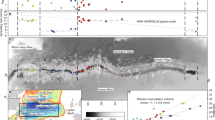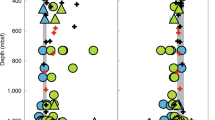Abstract
To fully understand the structure and dynamics of the Earth's convecting mantle, the origins of temperature variations within the mantle need to be resolved. Different hypotheses have been proposed to account for these temperature variations: for example, heat coming from the decay of radioactive elements or heat flowing out of the Earth's core. In addition, theoretical studies1,2,3,4,5 suggest that the thermal properties of continental masses can affect mantle convection, but quantitative data that could allow us to test these models are scarce. To address this latter problem, we have examined the chemistry of mid-ocean-ridge basalt—which reflects the temperature of the source mantle6,7—as a function of the distance of the ridge from the closest continental margin. No correlation is observed for oceanic ridges close to subduction zones or hotspots; subduction zones probably inhibit thermal transfer between the mantle beneath continents and ocean, whereas hotspots influence the major-element chemistry of ridge basalts, which makes their interpretation with respect to mantle temperature more difficult. However, we do observe a significant correlation for mid-oceanic basalts from the Atlantic and Indian oceans. From this, we conclude that the location of continental masses relative to active ridges influences the large-scale thermal structure of the mantle and we estimate that the mantle cools by 0.05 to 0.1 °C per kilometre from the continental margins.
This is a preview of subscription content, access via your institution
Access options
Subscribe to this journal
Receive 51 print issues and online access
$199.00 per year
only $3.90 per issue
Buy this article
- Purchase on Springer Link
- Instant access to full article PDF
Prices may be subject to local taxes which are calculated during checkout


Similar content being viewed by others
References
Olson, P. & Corcos, G. M. A boundary layer model for mantle convection with surface plates. Geophys. J. R. Astron. Soc. 62, 195–219 (1980)
Gurnis, M. Large-scale mantle convection and the aggregation and dispersal of supercontinents. Nature 332, 695–699 (1988)
Lowman, J. P. & Jarvis, G. T. Mantle convection flow reversals due to continental collisions. Geophys. Res. Lett. 20, 25485–25497 (1993)
Zhong, S. & Gurnis, M. Dynamic feedback between a continent-like raft and thermal convection. J. Geophys. Res. 98, 12219–12232 (1993)
Guillou, H. & Jaupart, C. On the effect of continents on mantle convection. J. Geophys. Res. 100, 24217–24238 (1995)
Klein, E. M. & Langmuir, C. H. Global correlations of ocean ridge basalt chemistry with axial depth and crustal thickness. J. Geophys. Res. 92, 8089–8115 (1987)
Langmuir, C. H., Klein, E. M. & Plank, T. Petrological systematics of mid-ocean ridge basalts: Constraints on melt generation beneath oceanic ridges. AGU Geophys. Monogr. 71, 183–280 (1992)
Humler, E., Thirot, J. L. & Montagner, J. P. Global correlations of mid-ocean ridge basalt chemistry with tomographic images. Nature 364, 225–228 (1993)
Langmuir, C. H. Deep thoughts on the mantle. Nature 364, 191–192 (1993)
Albarède, F. How deep do common basaltic magmas form and differentiate? J. Geophys. Res. 97, 10997–11009 (1992)
McKenzie, D. & Bickle, M. J. The volume and composition of melt generated by extension of the lithosphere. J. Petrol. 25, 625–679 (1988)
Niu, Y. & Batiza, R. An empirical method for calculating melt compositions produced beneath mid-ocean ridges: application for axis and off-axis (seamounts) melting. J. Geophys. Res. 96, 21753–21777 (1991)
Keen, M. J., Klein, E. M. & Melson, W. G. Ocean ridge basalt compositions correlated with palaeobathymetry. Nature 345, 423–426 (1990)
Humler, E., Langmuir, C. H. & Daux, V. Depth versus age: new perspectives from the chemical compositions of ancient crust. Earth Planet Sci. Lett. 173, 7–23 (1999)
Elder, J. The Bowels of the Earth 222 (Oxford Univ. Press, Oxford, 1976)
Anderson, D. L. Hot spots, polar wander, Mesozoic convection and the geoid. Nature 297, 391–393 (1982)
Schilling, J. G. et al. Thermal structure of the mantle beneath the equatorial Mid-Atlantic Ridge: inferences from the spatial variation of dredged basalt compositions. J. Geophys. Res. 100, 10057–10079 (1995)
Humler, E., Meyzen, C., Ludden, J. & Mevel, C. Geochemical variations in basaltic glasses from the South West Indian Ridge (49 to 69°E). Eos. 79, 878 (1998)
Müller, D. M., Royer, J. Y. & Lawver, L. A. Revised plate motions relative to the hotspots from combined Atlantic and Indian Ocean hotspot tracks. Geology 21, 275–278 (1993)
Acknowledgements
We thank C. Jaupart, A. Bonneville, L. E. Ricou, S. Labrosse, S. Gilder, P. Machetel and C. Sotin for discussions. We also thank V. Courtillot and M. Perfit for their comments and corrections, and E. Klein for comments on an earlier version of the manuscript. We used Paleomac software provided by J. P. Cogne (available at http://www.ipgp.jussieu.fr/~cogne).
Author information
Authors and Affiliations
Corresponding author
Ethics declarations
Competing interests
The authors declare that they have no competing financial interests.
Rights and permissions
About this article
Cite this article
Humler, E., Besse, J. A correlation between mid-ocean-ridge basalt chemistry and distance to continents. Nature 419, 607–609 (2002). https://doi.org/10.1038/nature01052
Received:
Accepted:
Issue Date:
DOI: https://doi.org/10.1038/nature01052
This article is cited by
-
Decrease in oceanic crustal thickness since the breakup of Pangaea
Nature Geoscience (2017)
-
High mantle temperatures following rifting caused by continental insulation
Nature Geoscience (2013)
-
Mapping absolute migration of global mid-ocean ridges since 80 Ma to Present
Earth, Planets and Space (2007)
Comments
By submitting a comment you agree to abide by our Terms and Community Guidelines. If you find something abusive or that does not comply with our terms or guidelines please flag it as inappropriate.



